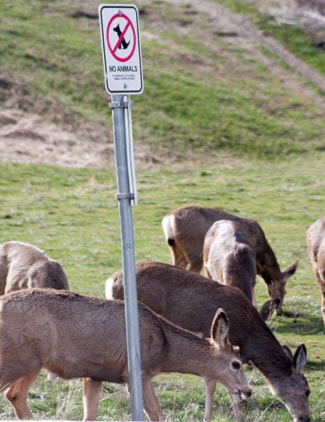Dealing with deer will take several plans of attack.
That was the message Penticton staff had for council, who were given a host of options to consider in the hopes of addressing ungulate overpopulation in city limits.
Anthony Haddad, the city’s development services director, detailed a lengthy report to council Monday on various deer conflict resolution options like hazing and frightening techniques, repellents, landscaping alternatives, fencing and vehicle mitigation, compared to some of the drawbacks of attempting to control fertility or relocate animals.
Whichever direction the city wants to go, he added, Penticton should consider as many avenues as possible to get there.
“Selecting one particular method would not be considered adequate,” Haddad said, adding that the city will also have to consider its budget as well. “There are a number of costs associated with any of these options.”
Haddad said Penticton is not the only municipality staring down doe-eyed issues. The problems around deer overpopulation are likely to come up at the Union of B.C. Municipalities meeting set for this fall.
Coun. Mike Pearce said he preferred the methods employed by the City of Kimberley, which drafted an 18-page deer management strategy that supported several methods. “It’s well-thought out,” he said.
According to Kimberley’s urban deer committee report, the Kootenay city noted a rise in conflicts in 2000 after urban mule deer numbers increased following a period of record snowfall. Residential areas provided protection from predators and abundant food, and also resulted in increased cougar sightings in town. An urban deer count was conducted last year, showing approximately 200 deer or 20 deer for every square kilometre in the Kimberley area.
The deer were wearing out their welcome. A survey found 81 per cent of Kimberley residents were concerned about aggressive deer. Anecdotal reports had deer attacking dogs, people with dogs and at least one mother pushing a stroller. Also, residents reported having spent approximately $650,000 to deal with deer damage.
Kimberley’s plan was drafted after observing operations conducted in Helena, Mont., where a trap and cull system began in 2008. That program set up clover traps and netting at residential properties where owners reported problem deer. If a deer was trapped, agents would collapse the trap, secure the deer, use a bolt gun on the animal and then remove the carcass on a sled. Wherever possible, the meat from culled deer was processed and purchased by food banks for their patrons.
Kimberley also initiated a controlled public hunt of antlerless deer on specific city-owned or private land on days of “reduced human activity,” according to the strategy. Hunters would have to secure permits from the city and a litany of several aspects would be regulated: days, number of participants each week, season and weapon types. Briefing sessions would also be required.
The city also launched an education campaign to teach residents about ways to discourage deer encroachment — like appropriate landscaping that uses deer-resistant plants, shrubs and repellents as well as fencing options — or feeding the animals.
Coun. Gary Litke said their efforts may be assisted by the time of the year. “It’s September — deer hunting season,” he said.
Council unanimously directed staff to write a deer management strategy based on the model from the City of Kimberley. It will be then be reviewed in committee for feedback before returning to council for final approval.
